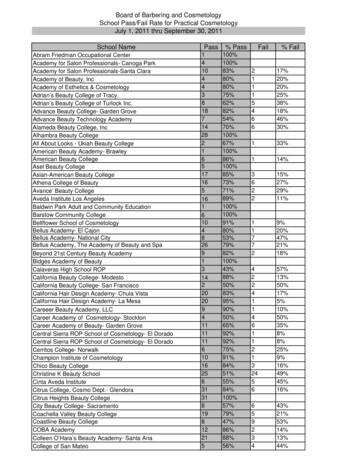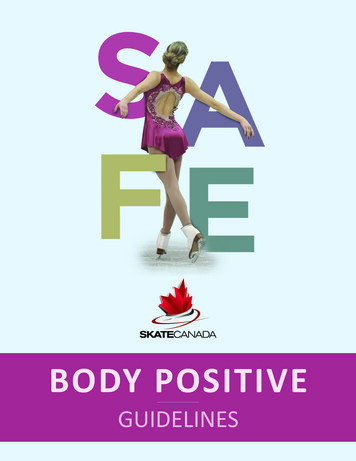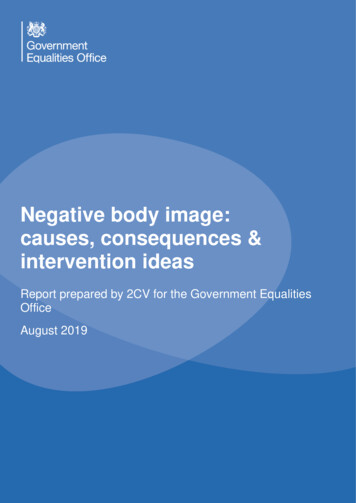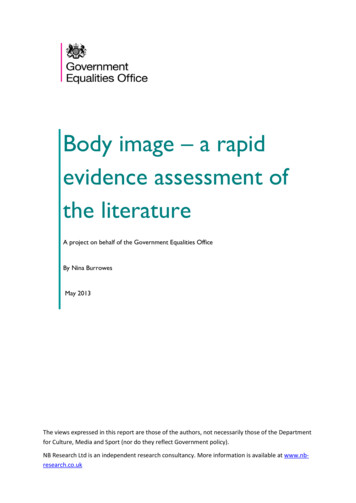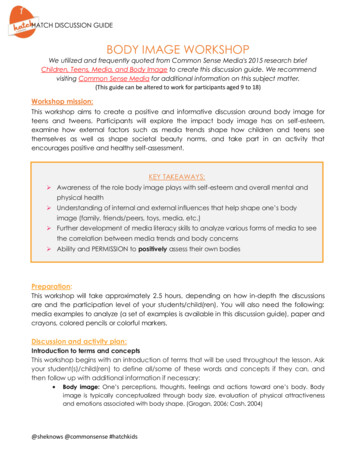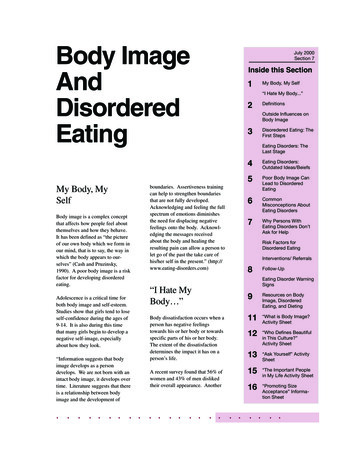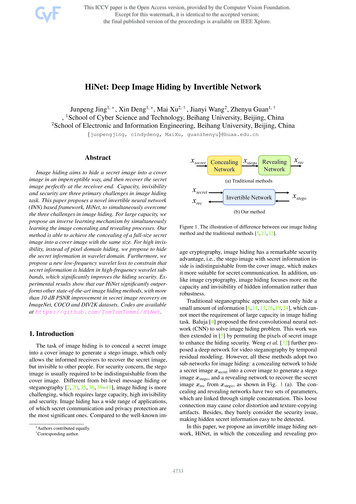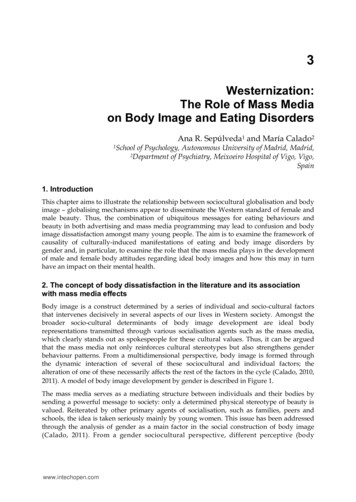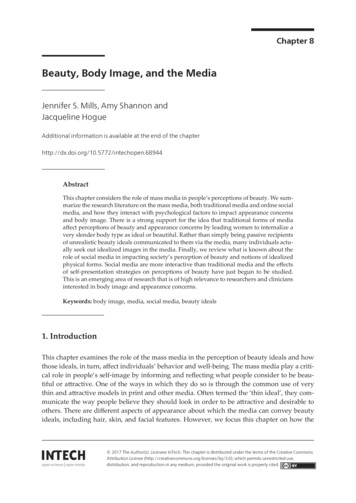
Transcription
DOI: 10.5772/intechopen.68944Provisional chapterChapter 8Beauty, Body Image, and the MediaBeauty, Body Image, and the MediaJennifer S. Mills, Amy Shannon andJacquelineHogueJenniferS. Mills,Amy Shannon andJacquelineHogueAdditional information is available at the end of the chapterAdditional information is available at the end of the bstractThis chapter considers the role of mass media in people’s perceptions of beauty. We sum‐marize the research literature on the mass media, both traditional media and online socialmedia, and how they interact with psychological factors to impact appearance concernsand body image. There is a strong support for the idea that traditional forms of mediaaffect perceptions of beauty and appearance concerns by leading women to internalize avery slender body type as ideal or beautiful. Rather than simply being passive recipientsof unrealistic beauty ideals communicated to them via the media, many individuals actu‐ally seek out idealized images in the media. Finally, we review what is known about therole of social media in impacting society’s perception of beauty and notions of idealizedphysical forms. Social media are more interactive than traditional media and the effectsof self‐presentation strategies on perceptions of beauty have just begun to be studied.This is an emerging area of research that is of high relevance to researchers and cliniciansinterested in body image and appearance concerns.Keywords: body image, media, social media, beauty ideals1. IntroductionThis chapter examines the role of the mass media in the perception of beauty ideals and howthose ideals, in turn, affect individuals’ behavior and well‐being. The mass media play a criti‐cal role in people’s self‐image by informing and reflecting what people consider to be beau‐tiful or attractive. One of the ways in which they do so is through the common use of verythin and attractive models in print and other media. Often termed the ‘thin ideal’, they com‐municate the way people believe they should look in order to be attractive and desirable toothers. There are different aspects of appearance about which the media can convey beautyideals, including hair, skin, and facial features. However, we focus this chapter on how the 2016 The Author(s). Licensee InTech. This chapter is distributed under the terms of the Creative Commons 2017 TheAuthor(s).Licensee InTech. This chapter is distributedwhichunderpermitsthe termsof the ommons.org/licenses/by/3.0),unrestricteduse, mons.org/licenses/by/3.0),whichpermits unrestricted use,andreproductionin anymedium, provided the original work is properlycited.distribution, and reproduction in any medium, provided the original work is properly cited.
146Perception of Beautymedia convey messages about body weight and shape ideals. For women in Western culture,a very common attitude is that thinness is beauty. We review the literature on the role of massmedia—both traditional media and newer, online media—and how they interact with psy‐chological factors to impact appearance concerns and body image.Body image is a multidimensional construct that refers to one’s perception of and attitudesabout the size and shape of one’s body. It has both a perceptual component that refers to howwe see our body size, shape, weight, physical characteristics, performance, and movement,and an evaluative component, which refers to how we feel about these attributes and howthose feelings influence our behaviors [1]. Body dissatisfaction is experienced when someoneperceives that their body falls short of the societal ideal in terms of size and/or shape, regard‐less of that person’s objective size or shape. In other words, body dissatisfaction is influencednot only by how we interpret societal ideals, but by how we perceive ourselves. Therefore,body dissatisfaction and perceptions of beauty are inextricably linked. Body dissatisfactionis the number one risk factor for a number of unhealthy behaviors, including clinical eatingdisorders and chronic dieting. Therefore, a delineation of the origins of body dissatisfaction isimportant not just for theories of perceptions of beauty, but for clinical and practical purposes.2. Effects of exposure to idealized media images on body imageIn modern times, most people living in developed countries encounter some type of mass media(e.g. television, music videos, movies, and magazines) on a daily basis. Thin ideal images oftenaccompany various advertised products, the pairing of which reinforces the idea that if you buyor use a particular product, you, too, can be beautiful. In the past two decades, there has beenan abundance of empirical research concerning the impact of exposure to idealized bodies in themedia on how people perceive and evaluate their own bodies. Most of this research has been onwomen, among whom the idea that ‘thin is beautiful’ is prevalent. Correlational studies typicallyexamine the association between naturalistic media consumption and various body image con‐structs, such as body perception, ideal body size, and body dissatisfaction. Experimental studiestypically expose participants to photographs of very thin and attractive models under varyingconditions and measure the participant’s subsequent body image. The latter type of studies canadvance our understanding of the causal effects of media on body image. Several meta‐ana‐lytic reviews of such studies have been conducted with regard to these findings. The first meta‐analysis of the effects of exposure to thin ideal media was conducted by Groesz et al. [2], whoexamined 25 experimental studies conducted between 1983 and 1998 involving a total of 2292participants. They concluded that women’s body image was significantly more negative afterviewing thin media images, as compared to after viewing control images or images of average‐sized or plus‐sized models, and that this effect was moderate in size.Although the previous meta‐analysis was limited to experimental studies, Grabe et al. [3]conducted a meta‐analysis of both experimental and correlational studies examining thelink between media exposure and body dissatisfaction, as well as internalization of the thinideal—the extent to which someone believes that a very slender body type is beautiful—in
Beauty, Body Image, and the en. They reviewed 90 studies and concluded that media exposure was associated withdecreased body satisfaction in women and that this effect was moderate in size. They alsoconcluded that media exposure was associated with increased internalization of the thin idealacross 23 studies and that the effect size was moderate.There is robust empirical support for the idea that exposure to idealized body images in tra‐ditional forms of media (e.g. magazines and television) affects perceptions of beauty andappearance concerns by leading women to internalize a very slender female body type asideal or beautiful. There is also support for the idea that exposure to the thin ideal is associ‐ated with body dissatisfaction in the moment among women. While most of the research onthis topic has been conducted with female participants, there is also some research on maleparticipants. Men’s and women’s body ideals vary considerably in Western cultures, wheremost of this research has been conducted. While women’s body ideal is slim, men’s is lean,but well‐defined and muscular. Blond [4] conducted a meta‐analysis of experimental researchconcerning the effects of exposure to media featuring the male muscular ideal on men’s bodyimage. In her review of 15 studies with a total of 1085 participants, she concluded that expo‐sure to images of idealized male bodies caused men to feel more dissatisfied with their ownbodies and that the effect size was small. In sum, we can say that the association betweenexposure to idealized body images in the media and body dissatisfaction holds true for bothmen and women, with the effect in women being slightly stronger than in men. There is noestablished cause for this gender difference to date.Although it has been established that exposure to idealized bodies in the media has signifi‐cant effects on how both men and women want to look (and, sometimes, how they think theydo look), it is important to emphasize that not all individuals respond to viewing idealizedimages in the same way. Research has revealed various individual differences that moderatethe impact of exposure to idealized images on body image. For example, a person’s psycho‐logical motives for viewing thin ideal media images can determine whether and how theyaffect that individual’s self‐perceptions of beauty.Social comparison refers to an individual’s tendency to compare oneself to other people andhas been found to moderate the impact of exposure to idealized media. Tiggemann and McGill[5] found that the effects of thin‐ideal advertisements on mood and body dissatisfaction weremediated by social comparison in a sample of 126 female undergraduate students such thatwomen who engaged in more social comparison experienced more negative mood and bodydissatisfaction after exposure to magazine advertisements containing images of thin‐idealizedfemale beauty. Indeed, social comparison, as either a psychological trait or state, is a reliablemoderator of the impact of idealized media exposure on both men and women. For example,Galioto and Crowther [6] found that trait social comparison as measured by a self‐report ques‐tionnaire predicted increased body dissatisfaction among male undergraduate students whoviewed muscular idealized men in advertisements. Moreover, Tiggemann et al. [7] furtherinvestigated the role of cognitive processing in the impact of idealized images on mood andbody dissatisfaction. They found that instructing women to engage in social comparison pro‐cessing (e.g. asking the participant to rate how much she would like her body to look like thatof a thin model) of thin‐ideal images led to greater negative mood and body dissatisfaction147
148Perception of Beautyas compared to a control condition. Interestingly, they also found that giving women fantasyinstructions to imagine themselves in the place of a thin model led to improved mood ascompared to control. In sum, the way that idealized images are cognitively processed is a keydeterminant in terms of the impact those images have on an individual’s self‐perceptions ofattractiveness or beauty. But little is yet known about why some people are more at risk forcomparing themselves to idealized images.Trait, dietary restraint has been found to moderate individuals’ responses to idealized bodyimages found in the media. Mills et al. [8] found that restrained eaters (i.e. chronic dieters) aredifferentially impacted by exposure to thin ideal media as compared to unrestrained eaters.Restrained eaters frequently attempt to lose weight by restricting what they eat. We con‐cluded that restrained eaters may be susceptible to a ‘thin fantasy’ when viewing ideal bodyimages. Specifically, restrained eaters, but not unrestrained eaters, rated both their ideal andcurrent body as thinner and felt more attractive as a result of viewing ideal body imagesin magazine advertisements. This effect was further moderated by thinness attainabilitybeliefs. Specifically, the immediate enhancement of women’s feelings of attractiveness fol‐lowing exposure to the thin ideal was stronger when dieters were led to believe that theycould lose weight through dieting, as compared to when they were told that losing weightis extremely difficult. In other words, under certain conditions, thin ideal media images canactually make women feel better about their appearance. These effects are presumed to beshort‐lived, although no research to date has examined how long self‐enhancement lasts afterexposure to thin ideal images.Further evidence that the context of the idealized images is important in terms of theirpsychological impact comes from a recent study by Veldhuis et al. [9]. The authors foundthat when self‐improvement messages accompanied images of idealized bodies, exposureincreased body satisfaction in a sample of undergraduate men and women, as compared toself‐evaluation messages or control. Knobloch‐Westerwick [10] also found that women, whomade self‐improvement (versus self‐evaluation) social comparisons in response to thin‐idealimages, had improved body satisfaction as opposed to decreased body satisfaction. In otherwords, the messages that accompany idealized body images commonly found in the mediamake a difference in terms of how people feel about their bodies after looking at them.Lastly, the psychological construct of body appreciation, or the extent to which one allowsnegative body‐related information to be rejected and positive information to be accepted, is anindividual difference variable that has been found to be protective against some of the negativepsychological impacts that stem from exposure to idealized media images. Andrew et al. [11]found that, in a sample of university women, participants with low body appreciation experi‐enced increased body dissatisfaction after exposure to thin‐ideal advertisements whereas indi‐viduals with high body appreciation did not. This lends support to the idea that women, whohave a positive bias in their perceptions of their body, are less likely to experience a negativeshift in body image in response to exposure to thin ideal media images.Body dissatisfaction is a major predictor of the development of clinically disordered eating.While it oversimplifies the psychopathology of eating disorders to suggest that exposureto thin ideal images causes eating disorders, thin ideal images do have significant health
Beauty, Body Image, and the Mediahttp://dx.doi.org/10.5772/intechopen.68944i mplications. For both women and men, the development of unhealthy weight control practicescan result from body dissatisfaction, such as strict or chronic dieting, excessive exercise,and steroid use. To mitigate the negative effects of thin ideal exposure on the health andwell‐being of their viewers, it has been suggested that magazines should contain disclaimerlabels if a photo has been retouched. In 2009, Australia’s National Advisory Group on BodyImage endorsed the use of warning labels by the advertising, media, and fashion industriesto indicate digitally altered images. Other countries have considered a similar public policy.Retouching of magazine photos can include enhancements of skin tone or texture, hair, ormake‐up, but most attention has been paid to retouching related to models’ weight andshape. Photos are often altered by magazines so that flesh is trimmed off in areas like thestomach and thighs, giving the appearance of a slimmer body. The idea is that if womenwere aware that media images are not real, they could distance themselves psychologicallyfrom unrealistic beauty standards and not be influenced by them. Unfortunately, resultsfrom this line of research suggest that disclaimer labels are generally not very effective interms of minimizing the negative effects of thin ideal images on viewers’ body image, mood/confidence, or intention to diet [12, 13]. In addition, a popular media literacy campaignaimed at diminishing the negative effects of exposure to the thin ideal (i.e. a 75‐second DoveEvolution video, showing all of the effort that goes into producing a photo of a model wholooks flawless) did not improve how women feel about their own appearance [14]. Clearly,cultural beauty standards as communicated by the media are powerful messages. Evenknowing that thin ideal images are not real does not stop women from wanting to achievethat standard of beauty.3. The media and perceived appearance normsIt could be that the mass media affect their audience not only by reinforcing beauty ideals(‘thin is beautiful’) or by eliciting immediate changes in terms of how people perceive andevaluate their own appearance, but also by influencing perceived norms. Experimental find‐ings demonstrate that perceptions of what is considered to be ‘average’, influence how indi‐viduals feel about their own bodies. In other words, one of the reasons that media‐portrayedthin ideal images can be harmful is because they skew what people think of as being ‘normal’or typical in a given population. There is no research to date directly testing the question ofwhether media images change people’s perceptions of what is considered average or typical.However, there is indirect evidence to support this idea. Studies show that women generallywant their bodies to appear a certain way depending on (1) what they think other people findattractive and (2) what they think the average person looks like.In a series of experimental studies, Bair et al. [15] examined the influence of normativebody ideals (i.e. the body type purported to be preferred by their peers) on body image.University students were told that their peers preferred the look of either relativelythinner or relatively heavier body types. In other words, we varied what participantsbelieved to be ‘beautiful’ to other people. The gender of the peers whose preferenceswere being reported was also manipulated. Participants then reported the body size they149
150Perception of Beautymost wanted to look like, from a range of hand‐drawn silhouettes. Women selected athinner personal ideal body size in the thin norm condition than in the heavy normcondition. This was true whether they were told what either men or other women foundmost attractive.In a related study by Mills et al. [16], we examined the effect of purported body normson ideal and current body size perception. In study one, female participants were givenbogus information about the average body size of women of the same age as participants.Current and ideal body size perceptions were then measured. Women reported a thinnerideal body size in the thinner norm condition than in the heavier norm condition, sup‐porting the idea that ideal body size is malleable. Women had shifted their ideal bodysize so that it was a bit thinner than what they believed the average woman’s body lookedlike. We interpreted these findings to mean that women may set their ideal as thinnerthan average so that they can be seen (or see themselves) as special. Study two replicatedthese results, but in a sample of young men. In this case, body norms were manipulatedthrough purported averages in terms of muscularity rather than thinness. Men had a moremuscular ideal body size in the more muscular norm condition than in the less muscularnorm condition.4. The bi‐directionality of media exposure and body dissatisfactionDespite the fact that they can contribute to body dissatisfaction, mass media featuringthin ideal images are popular forms of media. Many women and men choose to exposethemselves to idealized body images as featured in the media. This apparent paradox hasreceived little attention to date in the literature. Recently, we examined whether individualsdissatisfied with their bodies are actually more likely to seek out media featuring imagesof idealized bodies [17]. We hypothesized that the correlation between thin‐ideal mediaexposure and body dissatisfaction is in fact bi‐directional, and that people who feel badabout their appearance may actually consume higher levels of such media. It was predictedthat young women who were induced to feel dissatisfied with their bodies would gravi‐tate toward media featuring thin‐idealized content. In two experimental studies, a negativebody image rumination task was used to induce body dissatisfaction. Participants were thenasked to select their choice of different media (appearance‐related versus non‐appearance‐related) for an ostensible market research task. We found that young women who had justruminated about being unhappy with their bodies disproportionately selected magazine oronline video media that featured thin, idealized body imagery over non‐appearance‐relatedmedia. Young women who had been instructed to think about not liking their bodies thengravitated toward thinness‐related media that focused on dieting, fitness, health, and beauty.These findings warrant further replication, but suggest that people who are unhappy withtheir appearance may turn to media that feature thin, beautiful models, possibly for adviceor information, or to see advertised products aimed at bringing aspects of one’s appearancecloser to the perceived ideal [17].
Beauty, Body Image, and the Mediahttp://dx.doi.org/10.5772/intechopen.689445. The new media: social and online media and their influence on bodyimageMore and more people encounter online media on a daily basis. The Internet is commonlyused for social networking (i.e. online activities that create and maintain interpersonal rela‐tionships with family, friends, and acquaintances). Social media are particularly popularamong female young adults, a group in which body dissatisfaction is common [18]. Facebook,the most popular social media platform in the world, boasts over one billion daily users, withthree‐quarters of online American adults logging on [19]. Instagram, a popular photo‐sharingapplication, has 600 million users, half of whom use it daily, with 35% using it several times aday [19]. The majority of 18–29 year olds use Facebook and more than half of these individu‐als use Instagram [19]. These social media platforms and others—such as YouTube, Snapchat,and Pinterest—have a visual element and involve users posting photos of themselves for oth‐ers to see and on which to comment. Contemporary media platforms are changing how peopleinternalize beauty ideals, how they try to control how other people see them, and how theyget feedback from others about how they look.Most households worldwide have home Internet access, and, in some countries, children,adolescents, and young adults identify social media sites as their primary online communi‐cation activity [20]. Given that both social media use and body dissatisfaction are pervasiveamong adolescent and young adult women, it is not surprising that media and body imageresearch is expanding into this new media domain. The tripartite model of influence proposesthat peers, parents, and media are the main sources of the development of body image andeating disturbances. Furthermore, research shows that appearance comparison at least par‐tially mediates the relationships between these sociocultural factors and eating and weight‐related behaviors [21]. Each of these three sociocultural factors converges on social media.Until the past 5 years, research on Internet exposure, perceptions of beauty, and body imageconcerns was virtually non‐existent. In line with research on traditional forms of mass mediaand body image, recent correlational studies reveal that social media use is linked to bodyimage and appearance concerns among both men and women [22]. Also, much like the rela‐tionship between the traditional media and body image ideals, the link between social mediause and body image is not straightforward; it appears to be affected by various psychologicalfactors, such as individual differences in the tendency to compare one’s appearance to thatof others. When people compare themselves to others who they consider to be superior tothemselves it is known as upward social comparison. Downward social comparison is whenpeople compare themselves to other people who they consider to be inferior to them on somedimension. Exactly which individual and situational factors determine social comparisonprocesses on social media remain to be empirically tested. But because social comparisonmoderates the effects of traditional media on viewers, as reviewed above, it is likely that thesepsychological processes also play a role in the effects of social media on users.Unlike traditional forms of media like television, movies, and magazines, social media sitesare designed to actively engage the user. Since there are many ways for users to engage with151
152Perception of Beautyonline media, such as scrolling through newsfeeds and profiles, commenting on other users’posts, seeing who else has liked/commented/endorsed posts, or creating and uploading theirown content, it is difficult to tease apart exactly how online media are related to perceptionsof beauty. Researchers have started to use various research methods to study the link betweenonline media exposure and appearance concerns (e.g. qualitative data, correlational studies,and experimental simulated social media use) that may or may not be analogous to howpeople use social media in the real world. For instance, researchers have begun to bring socialmedia into the laboratory for study. When women passively view mock social media profilesversus models in magazines, there appears to be no difference between the media types interms of subsequent increases in appearance comparison and body image dissatisfaction [22].Although some researchers find that adolescent girls’ time spent on the Internet is positivelycorrelated with internalization of the thin ideal, body surveillance, and drive for thinness,experimental studies suggest that mere exposure to one’s own social media account does notnegatively or immediately impact young women’s appearance concerns [23–31].One of the unique aspects of social media, versus traditional media, is that they are madeup of communication with peers and/or public figures. It is the elements of interactivity andconnectedness that make social media distinct from other media forms and rife with opportu‐nities for users to perceive, compare, and internalize standards of beauty. Traditional medialiteracy efforts may have helped people think critically about how photos of models andcelebrities are frequently edited by advertisers and editors, and how they display completelyunrealistic standards of beauty. However, social media platforms expose users to photos ofreal‐world peers, which may dissuade people from critically analyzing the images they seeon social media. In truth, users can present their ideal selves through editing, enhancing,and embellishing their online images and appearance. More research is needed to determinewhether social media users engage in selective presentation of their own appearance, butoverlook the notion that other users have done the same.People can engage in a variety of behaviors related to perceptions of beauty in online forms ofmedia. Examples include taking multiple selfies and choosing to post only the flattering pho‐tos, using camera filters to enhance the appearance of a person’s face, and photo‐shoppingbody parts to make them appear thinner. Research is just starting to examine the relationsbetween these types of self‐presentation strategies on social media and well‐being (bodyimage and appearance self‐esteem) among women. A study of online dating website usersfound that individuals commonly managed their online profile by posting selfies of whichthey felt especially proud [32]. It is not yet known whether self‐presentation strategies likephoto enhancement actually improve body image and appearance self‐esteem (by allowingusers to present an idealized version of themselves to others) or whether they worsen appear‐ance concerns because they perpetuate an evaluation of and focus on physical appearance.It seems that people who post photos of themselves on social media probably do so when theyfeel good about their appearance. Indeed, research suggests that the use of social media pre‐dicts subsequent body dissatisfaction and not the other way round [33]. It could be, however,that social media users post photos of themselves when they feel especially good about theirappearance, but that they end up feeling worse about their appearance in the longer term
Beauty, Body Image, and the er frequent use of social media. The longer term adverse effects of social media use couldbe due to looking at images of idealized, and often retouched, photos of other people, as wellas reading online commentary about people’s appearance. Replication and clarification of thecausal effects of social media usage on body image and appearance self‐esteem is an importantgoal for future research in this field.Popular social media platforms have begun to acknowledge the risks inherent in exposure tocertain types of photos. At this time, Instagram has banned hashtags such as ‘thinspiration’and ‘proanorexia’ because Instagram views them as actively promoting self‐harm. These areterms that would be familiar to many social media users (particularly young women) andalert viewers to photos that are meant to glorify very thin bodies. Before content associatedwith eating disorders is shown, a graphic‐images warning and link to the National EatingDisorders website is displayed. Other appearance‐related hashtags, such as ‘sopretty’, ‘attrac‐tive’, ‘bikinibody’, and ‘everybodyisbeautiful’ are, at present, no longer searchable on thephoto‐sharing application [34]. Although it is not clear what the impetus was for Instagram toenact these guidelines, advocacy groups generally applaud these types of content moderationefforts aimed at the prevention of disordered eating and body image disturbances.In summary, research that addresses the question of whether posting, modifying, and view‐ing photos on social media hurts or helps women’s body image and appearance self‐esteemis currently underway. The available evidence and theory point to exposure to thin, ideal‐ized photos online, and taking and retouching selfies—which may masquerade as promot‐ing body positivity and esteem—as particularly risky behaviors in terms of body image andself‐esteem.6. ConclusionsOne of the ways in which the media affect perceptions of beauty is through the us
Keywords: body image, media, social media, beauty ideals 1. Introduction This chapter e
